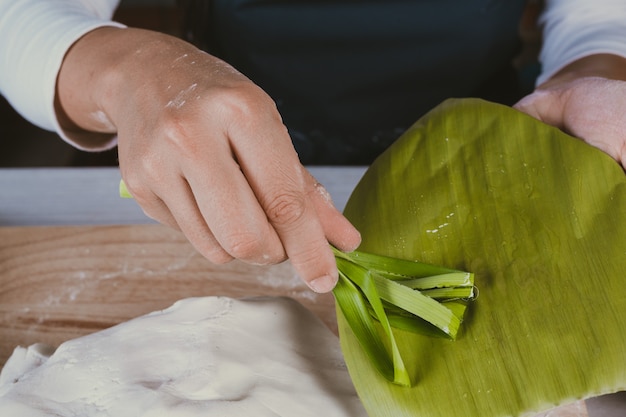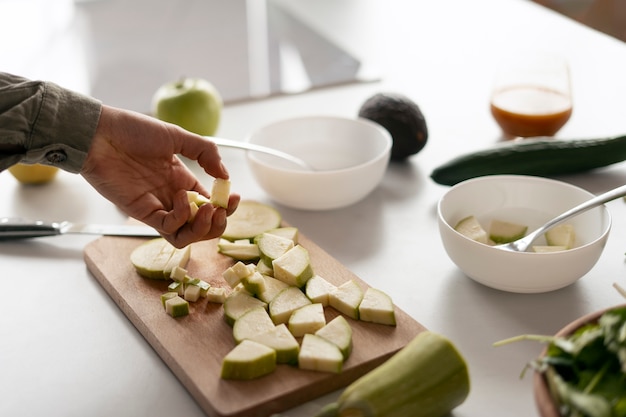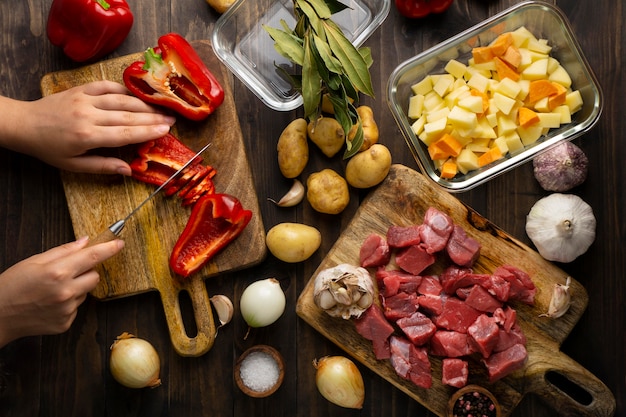Sago pearls, those little translucent, slightly chewy wonders that add a touch of exotic charm to desserts, have always held a special place in my heart. They're like tiny tapioca balls, but with more character, more bite, if you know what I mean. The moment you add a spoonful of sago to a dish, it transforms – a little more interesting, a little more adventurous.
But I'll admit, cooking sago can be a bit tricky. It's not as simple as boiling potatoes; it needs a bit of care, a bit of understanding. Fear not, though, because I'm here to share all my sago wisdom with you, from choosing the right pearls to achieving that perfect texture. So grab a cuppa, get comfy, and let's delve into the world of sago.
Part 1: Understanding Sago Pearls

What are Sago Pearls?
First things first, let's clear up what sago actually is. Those little pearly beauties aren't pearls at all. They're actually made from the starch extracted from the sago palm tree, a tropical plant native to Southeast Asia. It's been a staple in many Asian cuisines for centuries, and its versatility makes it a real culinary star.
Types of Sago Pearls
You might be surprised to learn that sago pearls come in different sizes and textures. They're generally categorized as:
- Small sago pearls: These are the most common type, about the size of a tiny pea. Their delicate texture makes them perfect for desserts, where they add that classic chewy bite.
- Large sago pearls: These are bigger, with a more pronounced texture. They add a nice "oomph" to salads and soups, giving them a delightful textural contrast.
There's also a "quick-cook" variety of sago pearls, which are pre-cooked to a certain extent and require less time on the stove. But I must confess, I'm not a big fan of these. They lack the satisfying chewiness of the regular sago pearls, which I find essential for that true sago experience.
Where to Buy Sago Pearls
Finding sago pearls is usually quite straightforward. You can find them in most Asian supermarkets, especially those specializing in Southeast Asian ingredients. Online retailers are another great option, particularly if you have a specific type or brand in mind. They often come in bags, sometimes even pre-soaked for your convenience.
Part 2: Preparing Sago Pearls

Now, let's get down to the nitty-gritty of preparing sago. It's not overly complicated, but it does require a bit of patience and attention to detail. Follow these steps for perfect results:
Washing and Soaking
First, give your sago pearls a gentle rinse under cold water to remove any dust or debris. Then, it's time to soak them. This step is crucial for softening the pearls and making them easier to cook. Soak them in cold water for at least 30 minutes, and up to an hour if you have time.
My grandmother, a culinary genius, always added a pinch of salt to the soaking water. She swore it helped prevent the pearls from sticking together. And you know what? She was right! It's a simple trick, but it makes a real difference.
Boiling Sago Pearls
Once the pearls are soaked, it's time to cook them. Bring a pot of water to a rolling boil, then add the sago pearls. Reduce the heat to a gentle simmer and cook, stirring occasionally to prevent sticking. The pearls should turn translucent and become slightly chewy – that's your cue they're almost ready.
cooking time depends on the size and type of pearls, but generally, it takes about 15-20 minutes.
Now, here's the most important tip: don't overcook the pearls! If you cook them for too long, they'll become mushy, and nobody wants mushy sago.
Testing for Doneness
To ensure your sago pearls are cooked to perfection, give one a little bite test. If it's soft and chewy but not mushy, it's ready! If it's still hard, give it a few more minutes.
Part 3: Sago Pearl Recipes and Variations

Sago pearls are incredibly versatile – they can be used in desserts, salads, soups, and even as a thickening agent. The possibilities are endless!
Classic Sago Desserts
Here are some of the classic sago desserts that have stood the test of time:
- Sago with Coconut Milk: A simple yet delightful dessert, perfect for a warm summer day. Cook sago pearls with coconut milk, sugar, and a pinch of salt. For an extra touch of fragrance, add a couple of pandan leaves while cooking.
- Sago with Mango: A popular dessert throughout Southeast Asia. Combine cooked sago pearls with fresh mango cubes, a touch of sugar, and a drizzle of rich coconut cream for a tropical delight.
- Sago with Red Bean: This traditional Chinese dessert is a comforting classic. Cook sago pearls with red bean paste, then add a touch of honey for sweetness. You can even add a pinch of salt to balance the sweetness.
Creative Sago Variations
Don't be afraid to get creative and explore the world of sago beyond the classics! Here are some adventurous ideas:
- Sago Pudding: Mix cooked sago pearls with creamy custard, whipped cream, and fresh fruit for a refreshing pudding. You can add a touch of vanilla extract for a more decadent flavor.
- Sago Salad: Combine sago pearls with fresh fruits like pineapple, grapes, and strawberries, and a light, tangy dressing. It's a delicious and light option for a summer picnic or barbecue.
- Sago Soup: Use sago pearls as a thickening agent for soups. They work particularly well in sweet soups, like coconut milk soup with taro and red beans. The sago adds a delightful texture and a subtle sweetness to the soup.
Part 4: Tips for Perfect Sago Pearls
Over the years, I've learned a few tricks to ensure perfect sago pearls every time. Follow these tips to avoid common pitfalls and get those pearls just right:
Don't Overcook
This is the most crucial tip. Overcooked sago pearls become mushy, losing their desirable texture. Keep a close eye on them while they're cooking, and don't hesitate to take them off the heat a bit early if you think they're getting too soft. It's better to err on the side of slightly undercooked than overcooked.
Use a Large Pot
When boiling sago pearls, it's important to use a large pot with plenty of water. This prevents the pearls from sticking together and ensures even cooking. Think of it like giving them space to move around and cook properly.
Stir Frequently
Don't let those pearls settle! Stir them occasionally while they're cooking. This will prevent them from sticking to the bottom of the pot and ensures they cook evenly.
Add a Pinch of Salt
Adding a pinch of salt to the boiling water helps to enhance the flavour of the sago pearls and prevents them from sticking together. It's a simple trick with big impact.
Let Cool in the Fridge
Once the sago pearls are cooked, let them cool down completely before using them in your recipe. This allows the texture to set properly and prevents the pearls from becoming mushy. A good way to do this is to transfer them to a bowl of ice water to stop the cooking process and cool them down quickly.
Part 5: Sago Pearls in Different Cuisines
Sago pearls are not just a dessert ingredient. They are used in diverse cuisines around the world, showcasing their versatility and popularity.
Southeast Asia
In Southeast Asia, sago is a staple ingredient in desserts, salads, and even soups. In Thailand, for example, they make a delightful sago dessert with mango, coconut milk, and a touch of sugar, a perfect way to cool down on a hot day. In Malaysia, sago is often used in a sweet soup called "bubur sago," which is made with coconut milk, sugar, and other ingredients like red beans and taro. It's a comforting and delicious dish.
China
In China, sago pearls are a common ingredient in desserts and snacks. They're often used in sweet soups, puddings, and even as a filling for mooncakes. Sago adds a delightful textural element to these treats.
Philippines
The Philippines has its unique take on sago. They use sago pearls in a dessert called "halo-halo," a colorful mix of shaved ice, fruits, jellies, and sweet beans. The sago adds a chewy contrast to this refreshing and vibrant dessert.
Other Regions
Sago pearls are also gaining popularity in other regions of the world. They're a fun and interesting addition to desserts, salads, and even savory dishes. Their versatility allows them to be incorporated into a wide range of culinary creations.
Part 6: Storage and Shelf Life
Now that you've cooked your sago pearls, it's important to store them properly to preserve their freshness and texture. Here's a guide to storing both cooked and uncooked sago:
Storing Cooked Sago
For cooked sago, place them in an airtight container and refrigerate them for up to 3 days. You can also freeze cooked sago for up to 3 months. Just make sure to thaw it completely before using it, as thawing in the refrigerator overnight is ideal.
Storing Uncooked Sago
Uncooked sago pearls can be stored in a cool, dry place for up to 6 months. Keep them in their original packaging, as this helps to protect them from moisture and air exposure.
Part 7: Sago Pearl Nutrition
Let's talk about the nutritional profile of sago pearls. While they're not a superfood, they do have some nutritional benefits.
Calories and Carbohydrates
Sago pearls are primarily composed of carbohydrates, providing a source of energy. They also contain a good amount of dietary fiber, which is important for digestive health.
Vitamins and Minerals
Sago pearls are a good source of iron and magnesium, both essential for various bodily functions. They also contain small amounts of calcium, potassium, and zinc.
Glycemic Index
The glycemic index (GI) of sago pearls is relatively low, meaning they don't cause a rapid spike in blood sugar levels. This can be beneficial for those managing their blood sugar levels.
Overall
While sago pearls are not a highly nutritious food, they can be a tasty and satisfying addition to your diet. Enjoy them in moderation as part of a balanced eating plan.
Part 8: Sago Pearls FAQs
1. What's the best way to tell if sago pearls are cooked?
The best way to tell if sago pearls are cooked is to bite into one. If it's soft and chewy but not mushy, it's ready! If it's still hard, give it a few more minutes on the stove.
2. Can I substitute sago pearls for tapioca pearls?
While tapioca pearls and sago pearls are similar in appearance, they have different textures. Tapioca pearls have a more gelatinous texture, while sago pearls are slightly chewier. You can substitute them for each other in some recipes, but you may need to adjust the cooking time.
3. Why do my sago pearls stick together?
There are a few reasons why your sago pearls might stick together:
- Overcrowding: You're using too many pearls in a small pot. Give them some space to move around freely.
- Not enough water: You're not using enough water to cook the pearls properly. Ensure you have enough water to cover the pearls comfortably.
- Not stirring enough: You're not stirring the pearls frequently enough to prevent them from sticking. Remember to stir occasionally to keep them moving.
4. What's the difference between white sago and brown sago?
There is no such thing as "brown sago". Sago pearls are typically white or translucent. You might be thinking of tapioca pearls, which are sometimes brownish in color.
5. What are some tips for cooking sago pearls without them becoming mushy?
Here are a few tips to prevent sago pearls from becoming mushy:
- Don't overcook them: Keep a close eye on the pearls while they're cooking, and take them off the heat as soon as they're done.
- Use a large pot: This helps to ensure that the pearls have plenty of room to cook evenly.
- Stir frequently: Stirring the pearls frequently prevents them from sticking to the bottom of the pot and becoming mushy.
So there you have it, my friends, a complete guide to cooking perfect sago pearls. Go forth and create delicious desserts, salads, and soups! I'm sure you'll impress everyone with your sago-making skills. Remember, with a bit of patience and practice, you'll be a sago master in no time!
Everyone is watching

Perfect Rice Every Time: The Ultimate Guide to Cooking Rice
Cooking TipsAs a self-proclaimed foodie, I've always been a bit obsessed with rice. It's the foundation of countless cuisi...

Ultimate Guide to Cooking the Perfect Thanksgiving Turkey
Cooking TipsThanksgiving. Just the word conjures up images of overflowing tables laden with delicious food, the scent of r...

The Ultimate Guide to Cooking Asparagus: Tips, Techniques, and Recipes
Cooking TipsAsparagus. The mere mention of this spring delicacy conjures up images of vibrant green spears, crisp and burs...

Can You Cook Spaghetti with Gasoline? (The Shocking Truth)
Cooking TipsWe've all seen those crazy internet trends. You know, the ones that make you wonder, "Did someone actually try...

Chorizo and Eggs Recipe: The Ultimate Guide
Cooking TipsRight, let’s talk about chorizo and eggs. You know, that classic Spanish dish that's always a winner. It's th...
